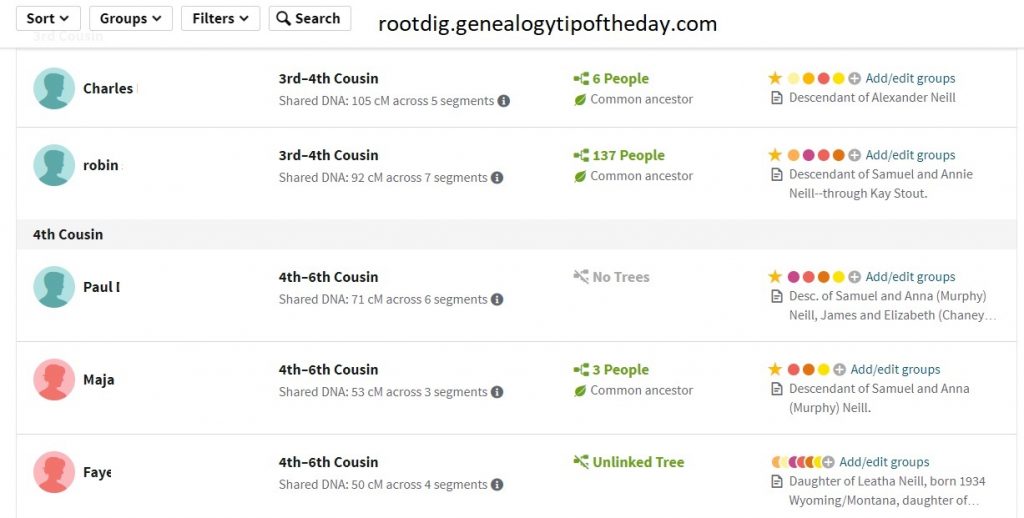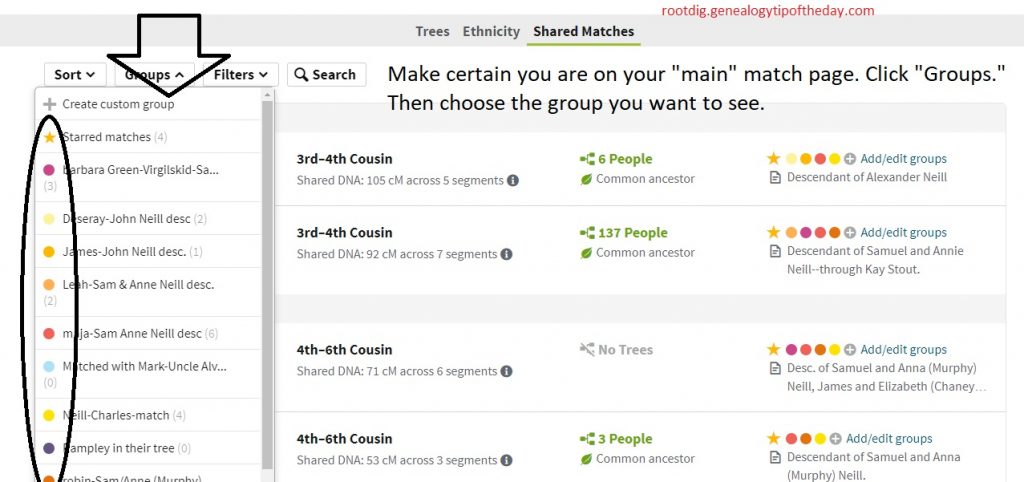
I’ve used the dots to help with some visual sorting of my DNA matches at AncestryDNA. Various shades of yellow/red/orange were used to “tag” shared matches I had with matches who were known descendants of John Neill of Drumachose Parish, County Derry, Ireland.
A match having more dots does not mean that match is more related to me. I started working the unknown matches who had the largest number of dots, hoping they would be easier to figure out. That was not always the case. What was helpful was keeping a master list of the names that had at least one dot (what AncestryDNA calls “groups”) handy. Those names that are in a group can easily be seen for a specific group by using the drop down menus in my AncestryDNA test results matches page.

While some of the user names (omitted in the illustration) are somewhat cryptic, enough of them (at least in my experience) are real names or relatively close enough to the real name, that having a list is handy when performing searches of databases, websites, etc. in an attempt to determine the identity of ancestry of a match.
My plan with using the dots was to temporarily assign them to matches of a known match in an attempt to determine other matches. I “star” matches that have been determined so that I can easily see who has been determined. My notes for a determined match always begin with “Descendant of.” That phrase usually shows up where the notes are partially displayed. Both things help me to quickly know if a match has been determined. It may be redundant, but since one never knows how AncestryDNA might change the interface in the future, I’ve decided not to change how I use the stars and the notes as I like to be able to quickly see what’s been figured out.
When I made dots on my Neill descendants who had done DNA testing at AncestryDNA, I did not make groups for all the shared matches of known Neill descendants. I only focused on certain branches of the family:
- descendants of Alexander Neill–son of John–who remained in Ireland and died there. Many of these descendants settled in the general area of Gary, Indiana, by the 1920s.
- descendants of Samuel Neill (died 1912)–son of John–who immigrated to Hancock County, Illinois, in the 1860s. Most of his descendants have lived in the area for several generations. The only descendants of Samuel whose DNA matches were analyzed were descendants of the following children:
- John
- Samuel
- William
- Joseph
Samuel had other children whose descendants have done DNA testing. They were not initially a part of my work on the Neill Irish matches. Those children, Charles (my great-grandfather), Mary, and Sarah, all married individuals who were also descendants of James and Elizabeth (Chaney) Rampley (my third great-grandparents) and Augusta and Melinda (Sledd) Newman (my fifth great-grandparents).
After I left out Charles, Mary, and Sarah Neill’s matches, I initially concentrated only on a subset of the Neill matches I had tagged: the descendants of Alexander Neill and Samuel’s son Joseph. Alexander’s family had never lived in or near Hancock County, Illinois, and their shared matches with me would not be likely to have some connection with each other that they did not have with me. Samuel’s son Joseph had only one child who grew up in and lived in Montana where most of his family remained. They were also unlikely to share duplicate connections.
A “Final” Thought on Dots
Dots are for sorting. The best way to sort depends in part on the genealogical and DNA tree of the testee. Currently users have twenty-four dots (which AncestryDNA calls “groups”). I’ve decided to reserve at least twenty of these dots for temporary sorting purposes–when I’m working on a certain subset of my matches.
But I’m thinking of assigning some dots permanently to a group to help me with my analysis over the long term. Doing that effectively requires some analysis of my known ancestry.
My maternal ancestry consists of immigrants from a handful of Ostfriesen villages who basically settled in three small settlements in Hancock and Adams Counties in Illinois. Many of the families were related to each other before they crossed the pond and the number of multiple relationships only increased in the first few generations after their settlement beginning in the 1860s. I’ve got numerous double and triple cousins that only requires tracing the lineage back to my third or fourth great grandparents. Many of these matches are related to each other in additional ways that do not immediately connect to me. This compounds the analysis. I thought about reserving a dot for a match that I know is to my maternal side, but decided not to. The main reason for this is that I have a fair share of my maternal matches determined already and the shared matches of any match usually makes it abundantly clear to me that a match is related through my maternal side.
When I sifted through my Irish immigrant matches, I decided where another permanent “flag” or two would be helpful on my matches on my paternal side:
- known or probable descendants of the “Neill/Rampley/Newman” dynasty (descendants of Charles, Mary, and Sarah Neill from above). The word “dynasty” is an exaggeration, but given the shared ancestry the spouses of these Neill siblings have knowing that is helpful for my analysis.
- DNA matches who appear to have significant southwestern Hancock County or northwestern Adams County connections. I need to firm up my definition of who would fit into this category, but in viewing my Neill and other paternal matches, I’ve run across several individuals who were both related to me and who were related to each other on a separate family. What we had in common was that our families had lived in this general area for several generations–increasing the chance that there were multiple relationships. This is something I need to know about the match throughout the long term as I analyze my matches as it impacts more than just one subset of my matches.
I don’t want to have too many permanent group/dot categories as I want them to be something that when I see it, I can easily remember it. I also want the permanent group/dot categories to be something that will actually help me with my matches and not just an exercise I do because I can and so that I can say I did it. There needs to be a purpose.
Learn more about my AncestryDNA 2019 webinar–available for immediate download.

2 Responses
I use the dots for specific ancestral lines plus for various larger mystery clusters and for mystery matches who don’t seem to be connected to one of my ancestral lines nor with some of my larger mystery clusters. Now I am working through each group to weed out matches where I have no hope of identifying the source of the match
I’ve used the Ancestry dots as a sort of Leeds Method for sorting my matches.
For the DNA test on my spouse, I set aside 2 colors for whether a DNA Match matches his sister or not. This allows me to quickly sort his DNA Matches and more easily interact with his sister who is also working on her own genealogy and DNA test and Matches. The number of Matches that two siblings do not share continues to blow my mind, but they can still be useful for researching additional ancestors.
Since we can search on colors or stars, but not non-stars, I have used the stars for the matches I have not yet resolved. If the colored dots are not enough to remind me how someone connects, I have included more info in the notes. I usually start with the surname(s) involved so I can see that part of the Note without having to completely open it. I also state in my Notes if I have “treed” the match in my tree. I had started out noting DNA matches on all blood-related ancestors of a DNA Match, and that has been very useful (visible) on my spouse’s ancestors who I am researching with my sister-in-law, but became too time-consuming for all of the DNA tests I manage. Now I just add a space and star after the middle name of a blood-related ancestor of a DNA Match, so I can quickly and easily go up and down the ancestors of a DNA Match to the mutual ancestors. This has been especially useful for the “quick and dirty” branches I have built for DNA Matches I still do not know how those DNA Matches connect. I know Ancestry has other features for notating a blood relative, but I have not used them because I am interested in something I know I will be able to quickly and easily see in any downloads I make and using my tree in other programs.
Although the Leeds Method would not normally result in more clusters than the number of colors Ancestry has chosen to provide, I am frustrated by Ancestry’s use of such a limited number of sorters, instead of numbers which could have been infinite and readily visible no matter how many I use, unlike too many shades of colors I already can’t distinguish between without looking at the labels I gave them anyway. I have run out of colors on 3 of the DNA tests I manage, which means I don’t have colors for some of the larger mystery clusters I have found.